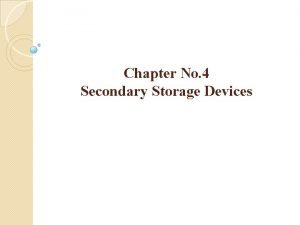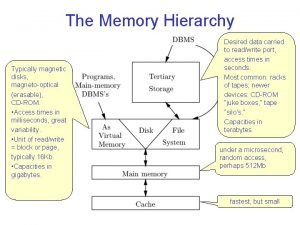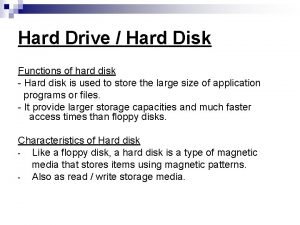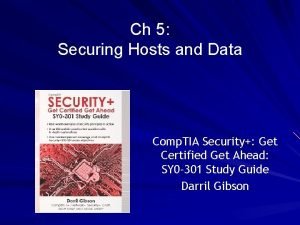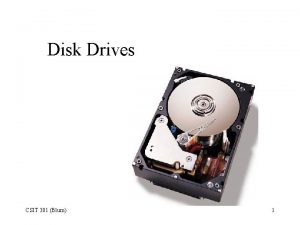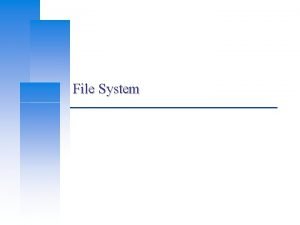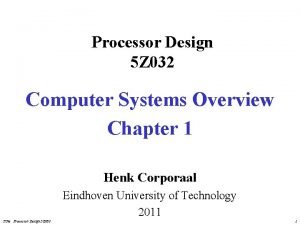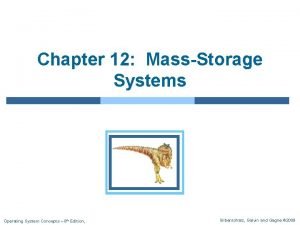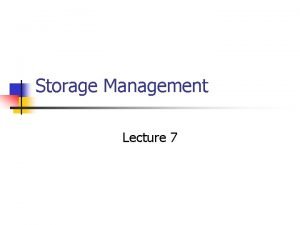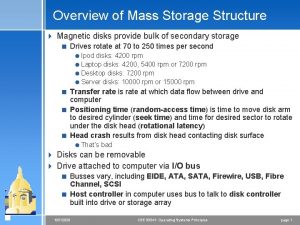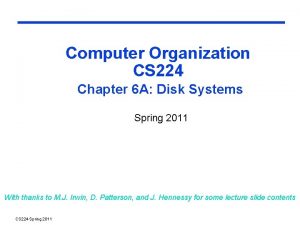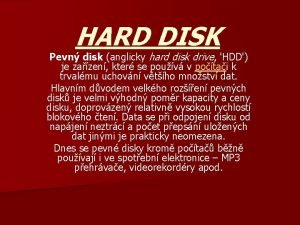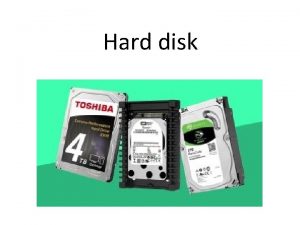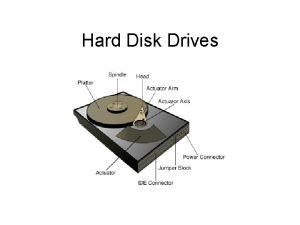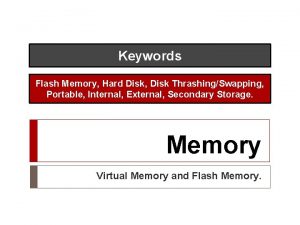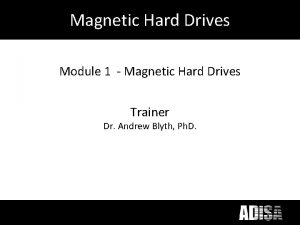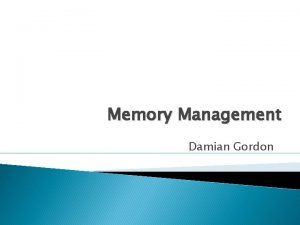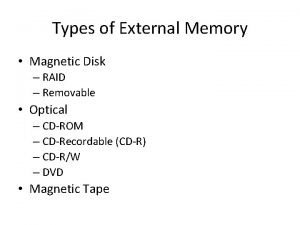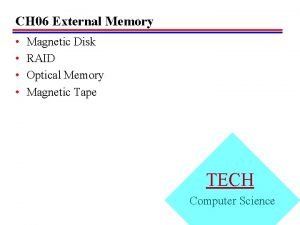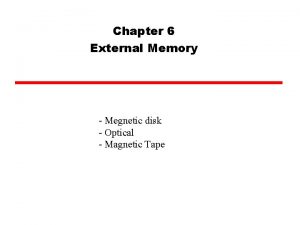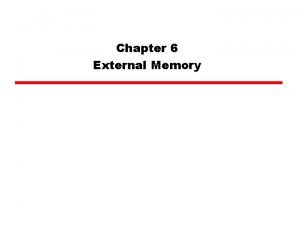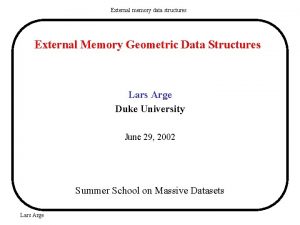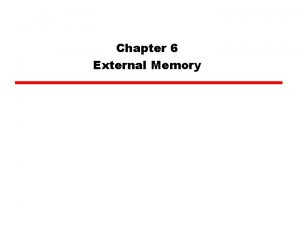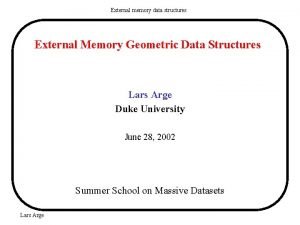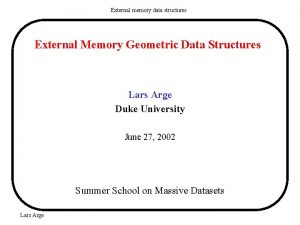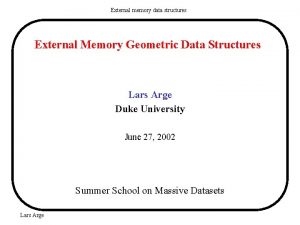External Memory Magnetic Disk Hard Disk DriveHDD Magnetic













![1] RAID Level 0 • RAID level 0 is not a true member of 1] RAID Level 0 • RAID level 0 is not a true member of](https://slidetodoc.com/presentation_image_h2/709713253f67c2fcb3ce9ae99b1a62cf/image-14.jpg)
![2] RAID Level 1 • RAID 1 differs from RAID levels 2 to 6 2] RAID Level 1 • RAID 1 differs from RAID levels 2 to 6](https://slidetodoc.com/presentation_image_h2/709713253f67c2fcb3ce9ae99b1a62cf/image-15.jpg)
![3] RAID Level 2 • RAID levels 2 and 3 make use of a 3] RAID Level 2 • RAID levels 2 and 3 make use of a](https://slidetodoc.com/presentation_image_h2/709713253f67c2fcb3ce9ae99b1a62cf/image-16.jpg)
![4] RAID Level 3 • RAID 3 is organized in a similar fashion to 4] RAID Level 3 • RAID 3 is organized in a similar fashion to](https://slidetodoc.com/presentation_image_h2/709713253f67c2fcb3ce9ae99b1a62cf/image-17.jpg)
![5] RAID Level 4 • As in the other RAID schemes, data striping(bitwise) parity 5] RAID Level 4 • As in the other RAID schemes, data striping(bitwise) parity](https://slidetodoc.com/presentation_image_h2/709713253f67c2fcb3ce9ae99b1a62cf/image-18.jpg)
![6] RAID Level 5 • RAID 5 is organized in a similar fashion to 6] RAID Level 5 • RAID 5 is organized in a similar fashion to](https://slidetodoc.com/presentation_image_h2/709713253f67c2fcb3ce9ae99b1a62cf/image-19.jpg)

- Slides: 20

External Memory

Magnetic Disk / Hard Disk Drive(HDD) Magnetic disk is made up of magnetizing principle for reading/ writing mechanisms Platter: • HDD consist of Platter over which data can be stored • A platter is a circular shaped constructed of nonmagnetic material, called as substrate, coated with a magnetizable material. Traditionally, platter substrate has been made up of an aluminum or aluminum alloy material. • Nowadays, glass substrates have been introduced as a platter material.

Magnetic Read and Write Mechanisms • Data are recorded on and later retrieved from the disk via a conducting coil named the head. • During a read or write operation, the head is stationary while the platter rotates beneath it. • The write mechanism, electricity flowing through a coil produces a magnetic field. Electric pulses are sent to the write head, and the resulting magnetic patterns are recorded on the surface below

Read/Write Head

Hard Disk Drive(HDD) and Platter

Data Organization and Formatting • The head is a relatively small device capable of reading from or writing to a portion of the platter rotating beneath it. • Basically, the organization of data on the platter surface is in a concentric set of rings, called tracks • Each track is of same width as the head width and there are thousands of tracks per surface • Adjacent tracks are separated by gaps. This prevents, or at least minimizes errors due to misalignment of the head or simply interference of magnetic fields.

Data Organization and Formatting • Data are transferred to and from the disk in sectors. There are typically hundreds of sectors per track, and these may be of either fixed or variable length.

Disk Format (Seagate ST 506)

Disk Format (Seagate ST 506) • Each track contains 30 fixed-length sectors of 600 bytes each. Each sector holds 512 bytes of data plus control information useful to the disk controller. • The ID field is a unique identifier or address used to locate a particular sector. • The SYNCH byte is a special bit pattern that indicate the beginning of the field. • The track number identifies a track on a surface. • The head number identifies a head. • The ID and data fields each contain an error detecting code.

Disk Performance Parameters • When the disk drive is operating, the disk is rotating at constant speed. • To read or write, the head must be positioned at the desired track and at the beginning of the desired sector on that track. • The time it takes to position the head at the track is known as seek time. • The time it takes for the beginning of the sector to reach the head is known as rotational delay, or rotational latency. • The sum of the seek time and the rotational delay equals the access time. • The time required for the data transfer is the transfer time.

RAID • Redundant Array of Independent Disks • The RAID scheme consists of seven levels, zero to six • Characteristics of RAID: 1] RAID is a set of physical disk drives viewed by the operating system as a single logical drive. 2] Data are distributed across the physical drives of an array. 3] It allows to store parity information, which guarantees data recoverability in case of a disk failure.

RAID Levels

RAID Levels
![1 RAID Level 0 RAID level 0 is not a true member of 1] RAID Level 0 • RAID level 0 is not a true member of](https://slidetodoc.com/presentation_image_h2/709713253f67c2fcb3ce9ae99b1a62cf/image-14.jpg)
1] RAID Level 0 • RAID level 0 is not a true member of the RAID family because it does not include redundancy to improve performance. • For RAID 0, the user and system data are distributed across all the disks in the array. This has a notable advantage over the use of a single large disk. • E. g. If two different I/O requests are pending for two different blocks of data, then there is a good chance that the requested blocks are on different disks. Thus, the two requests can be issued in parallel.
![2 RAID Level 1 RAID 1 differs from RAID levels 2 to 6 2] RAID Level 1 • RAID 1 differs from RAID levels 2 to 6](https://slidetodoc.com/presentation_image_h2/709713253f67c2fcb3ce9ae99b1a62cf/image-15.jpg)
2] RAID Level 1 • RAID 1 differs from RAID levels 2 to 6 in the way in which redundancy is achieved. • In other RAID schemes, some form of parity calculation is used to introduce redundancy, whereas in RAID 1, redundancy is achieved by the simple method of duplicating all the data. • So that every disk in the array has a mirror disk that contains the same data.
![3 RAID Level 2 RAID levels 2 and 3 make use of a 3] RAID Level 2 • RAID levels 2 and 3 make use of a](https://slidetodoc.com/presentation_image_h2/709713253f67c2fcb3ce9ae99b1a62cf/image-16.jpg)
3] RAID Level 2 • RAID levels 2 and 3 make use of a parallel access technique. • In a parallel access array, all member disks participate in the execution of every I/O request. • With RAID 2, an error-correcting code is calculated across corresponding bits on each data disk, and the bits of the code are stored in the corresponding bit positions on multiple parity disks. • Typically, a Hamming code is used, which is able to correct single-bit errors and detect double-bit errors.
![4 RAID Level 3 RAID 3 is organized in a similar fashion to 4] RAID Level 3 • RAID 3 is organized in a similar fashion to](https://slidetodoc.com/presentation_image_h2/709713253f67c2fcb3ce9ae99b1a62cf/image-17.jpg)
4] RAID Level 3 • RAID 3 is organized in a similar fashion to RAID 2. • The difference is that RAID 3 requires only a single redundant disk, no matter how large the disk array is. • RAID 3 also allows parallel access
![5 RAID Level 4 As in the other RAID schemes data stripingbitwise parity 5] RAID Level 4 • As in the other RAID schemes, data striping(bitwise) parity](https://slidetodoc.com/presentation_image_h2/709713253f67c2fcb3ce9ae99b1a62cf/image-18.jpg)
5] RAID Level 4 • As in the other RAID schemes, data striping(bitwise) parity is calculated. • In the case of RAID 4 to 5, the strips are relatively large. • With RAID 4, a block level parity is calculated across corresponding strips on each data disk, and the parity bits are stored at last corresponding disk of each row.
![6 RAID Level 5 RAID 5 is organized in a similar fashion to 6] RAID Level 5 • RAID 5 is organized in a similar fashion to](https://slidetodoc.com/presentation_image_h2/709713253f67c2fcb3ce9ae99b1a62cf/image-19.jpg)
6] RAID Level 5 • RAID 5 is organized in a similar fashion to RAID 4. • The difference is that RAID 5 distributes the parity strips across all disks in round robin fashion.

Data Mapping for a RAID Level Array
 What are magnetic storage devices
What are magnetic storage devices Magnetic disk in memory hierarchy
Magnetic disk in memory hierarchy Internal memory and external memory
Internal memory and external memory What makes hard water hard pre lab answers
What makes hard water hard pre lab answers Work hard have fun make history
Work hard have fun make history Hard times hard drive
Hard times hard drive Hard disk definition and function
Hard disk definition and function Portable hard disk
Portable hard disk Seek time in magnetic disk
Seek time in magnetic disk Hard disk 301
Hard disk 301 Computer hard disk
Computer hard disk Hard disk 1 (301)
Hard disk 1 (301) Nkb032 power device
Nkb032 power device Camara espaciadora inhalador
Camara espaciadora inhalador Fixed hard disk
Fixed hard disk Windows xp vm download
Windows xp vm download Dynamic disk vs basic disk performance
Dynamic disk vs basic disk performance Magnetic retentivity
Magnetic retentivity Structure of magnetic disk
Structure of magnetic disk Uses of magnetic disk
Uses of magnetic disk Magnetic disk
Magnetic disk
